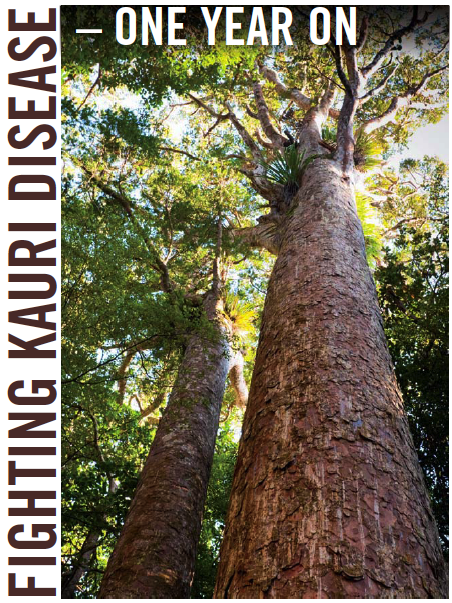PESTS AND DISEASES OF FORESTRY IN NEW ZEALAND
Fighting Kauri disease - one year on
From Biosecurity Issue 101, December 2010.
Six government agencies and Maori are continuing to work together to try to stop the spread of a disease that affects kauri trees.
 Kauri dieback (Phytophthora taxon Agathis or PTA) is a recently discovered disease that can kill kauri trees of all ages and sizes. Kauri dieback appears to affect only kauri, and is believed to be a soil-borne disease spread mainly through soil and soil–water movement and transferred by people, tracked from place to place on shoes, equipment and tyres. Affected trees show yellowing leaves, canopy thinning, dead branches and lesions that bleed resin across the lower part of the trunk.
Kauri dieback (Phytophthora taxon Agathis or PTA) is a recently discovered disease that can kill kauri trees of all ages and sizes. Kauri dieback appears to affect only kauri, and is believed to be a soil-borne disease spread mainly through soil and soil–water movement and transferred by people, tracked from place to place on shoes, equipment and tyres. Affected trees show yellowing leaves, canopy thinning, dead branches and lesions that bleed resin across the lower part of the trunk.
The kauri dieback management programme came into being a year ago as a response to identify and manage the risks to kauri. In late 2009, Cabinet, tangata whenua and regional councils opted to work together to protect New Zealand’s ancient kauri forests.
The six agencies involved – MAF Biosecurity New Zealand, the Department of Conservation, Auckland Council, Northland Regional Council, Bay of Plenty Regional Council and Environment Waikato – are working together and with Maori to develop the programme’s strategy. This is to protect kauri by containing the disease to infected sites, reducing its impact within those sites, preventing or slowing its spread across the kauri region and concentrating efforts to keep high-value sites disease free.
During the programme’s first nine months, the key was to learn more about kauri dieback and how to manage it, put protection measures in place (such as upgrading tracks and installing cleaning facilities at forest entrances and exits) and inform forest users about their part in the success of the programme. Another important focus was to develop the programme’s management plan and finalise the core team to deliver it.
The programme has already developed simple diagnostic tools to identify whether PTA is present in an area so the next priority is to get a detailed understanding of where the disease is located.
This surveillance data will refine the programme’s strategy, allowing efforts to be targeted or re-evaluated if the disease proves more widespread. As the status of key kauri sites is clarified, the best mix of protective measures will be implemented at each site – whether it be signage and interpretation, track hygiene stations, track upgrades, track rerouting or animal vector control and closure.
Lisa Gibbison, Senior Communications Adviser, MAF Biosecurity New Zealand lisa.gibbison@maf.govt.nz
For more information on kauri dieback and preventing its spread visit www.biosecurity.govt.nz/pests/kauri-dieback

 Farm Forestry New Zealand
Farm Forestry New Zealand

